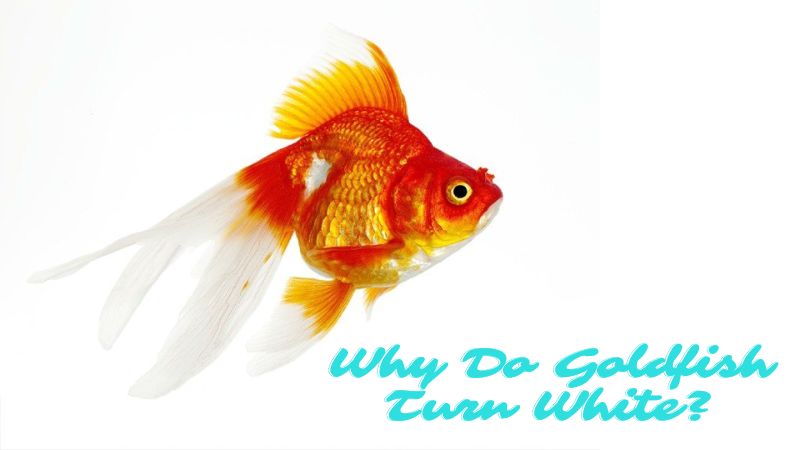Goldfish, known for their vibrant colors and graceful swimming, are popular pets around the world. However, many goldfish owners may be surprised and concerned when their goldfish start turning white. There are several reasons why this color change occurs, ranging from environmental factors to health issues. Understanding these reasons can help goldfish owners take appropriate measures to maintain the health and appearance of their aquatic pets. Tropical Fish Haven will help you find out why do goldfish turn white so you can take timely action.
Why Do Goldfish Turn White?
Genetics and Natural Aging
One of the most common reasons for goldfish turning white is genetics. Some goldfish are predisposed to change color as they age. Just as humans can go gray with age, goldfish can lose their vibrant hues and turn white or paler over time. This change is often gradual and can start when the fish is a few years old. It’s important to note that this process is natural and usually does not indicate a health problem.
Environmental Factors
Light Exposure
Light plays a significant role in the coloration of goldfish. Goldfish exposed to consistent, adequate lighting usually maintain their color better than those kept in dimly lit environments. Insufficient light can lead to a loss of pigmentation, causing the fish to turn white. Similarly, sudden changes in lighting conditions can stress the fish and lead to color changes.
Water Quality
Poor water quality is another critical factor that can cause goldfish to turn white. Goldfish are sensitive to changes in their environment, and poor water conditions can stress them out. High levels of ammonia, nitrites, or nitrates, as well as low oxygen levels, can lead to a loss of color. Regular water changes, proper filtration, and monitoring water parameters are essential to prevent this issue.
Diet and Nutrition
A balanced diet is crucial for maintaining the vibrant color of goldfish. Goldfish require a diet rich in carotenoids, which are pigments found in certain foods. Commercial goldfish foods often contain these pigments, but it’s important to ensure the diet is varied and includes high-quality food. A lack of essential nutrients can lead to a loss of color, resulting in the fish turning white.
Stress and Health Issues
Stress
Stress is a significant factor that can cause goldfish to turn white. Various stressors, such as overcrowding, aggressive tank mates, and rapid changes in water temperature, can affect the fish’s health and coloration. A stressed goldfish will often show signs of color loss as its body tries to cope with the adverse conditions.
Diseases and Parasites
Diseases and parasites can also lead to a change in color. Infections, such as bacterial or fungal infections, can cause a goldfish to lose its vibrant color and turn white. Parasites like ich (Ichthyophthirius multifiliis) can also lead to white spots or patches on the fish’s body. Regular health checks and prompt treatment of any illnesses are essential to maintain the health and color of goldfish.
Genetic Factors
Some goldfish breeds are more prone to color changes than others. Fancy goldfish varieties, such as the Pearlscale or the Oranda, may be more likely to experience color changes due to their genetic makeup. Breeding practices can also play a role, as some goldfish are bred for specific color traits that may change over time.
How to treat goldfish turning white
When a goldfish starts turning white, it can be a sign of various underlying issues ranging from natural aging to environmental factors and health concerns. Treating this condition effectively involves identifying the cause and taking appropriate action. Here’s a comprehensive guide on how to treat goldfish that are turning white.
Assess and Improve Water Quality
Regular Water Testing
Use a water testing kit to check the levels of ammonia, nitrites, nitrates, pH, and other essential parameters.
Optimal levels are:
- Ammonia: 0 ppm
- Nitrites: 0 ppm
- Nitrates: < 20 ppm
- pH: 6.5-7.5
Proper Filtration
- Ensure your aquarium filter is functioning correctly and is appropriate for the size of your tank.
- Clean or replace filter media as needed to maintain effective filtration.
Ensure Adequate Lighting
Consistent Lighting
- Provide consistent and adequate lighting for your goldfish. Goldfish need about 12 hours of light daily to maintain their coloration.
- Avoid sudden changes in lighting conditions to reduce stress.
Natural Light
Place the aquarium where it can receive indirect natural light, but avoid direct sunlight, which can cause overheating and algae growth.
Provide a Balanced Diet
High-Quality Food
- Feed your goldfish a balanced diet that includes high-quality commercial goldfish pellets or flakes.
- Look for foods rich in carotenoids, which help maintain vibrant coloration.
Supplementary Foods
Supplement their diet with fresh vegetables (such as peas, lettuce, and spinach) and occasional live or frozen foods (such as brine shrimp or bloodworms).
Minimize Stress
Proper Tank Setup
- Ensure the tank is appropriately sized for your goldfish. Overcrowding can cause stress, leading to color loss.
- Provide hiding spots and decorations to create a comfortable environment.
Stable Environment
- Maintain stable water temperatures and avoid rapid fluctuations.
- Use a heater to keep the temperature consistent if necessary (ideal temperature range for goldfish is 65-75°F or 18-24°C).
Compatible Tank Mates
Avoid keeping goldfish with aggressive or incompatible tank mates that could stress them out.
Monitor and Treat Health Issues
Treating Infections
- If you notice signs of bacterial, fungal, or parasitic infections, treat your goldfish promptly with appropriate medications.
- Common treatments include anti-parasitic medications for ich (white spot disease) or anti-fungal treatments for fungal infections.
Understanding Natural Causes
Aging and Genetics
- Recognize that some goldfish may naturally turn white due to aging or genetic factors. This is particularly common in some fancy goldfish breeds.
- If the color change is gradual and the fish appears healthy otherwise, it may simply be a natural part of their life cycle.
Seek Professional Advice
Veterinary Consultation
- If you’re unable to determine the cause of the color change or if your goldfish shows signs of illness, consider consulting an aquatic veterinarian.
- A vet can provide professional diagnosis and treatment recommendations tailored to your specific situation.
Preventive Measures
To prevent or minimize the risk of your goldfish turning white, consider the following measures:
- Consistent Lighting: Ensure your goldfish tank has consistent and adequate lighting. Avoid sudden changes in light exposure to reduce stress.
- Maintain Water Quality: Perform frequent water changes and use a high-quality filtration system to keep the water clean and oxygenated.
- Balanced Diet: Provide a varied and balanced diet rich in carotenoids and other essential nutrients. High-quality commercial goldfish food supplemented with fresh vegetables and occasional live food can help maintain vibrant coloration.
- Reduce Stress: Create a calm and stable environment for your goldfish. Avoid overcrowding the tank, provide hiding spaces, and ensure the water temperature remains stable.
- Monitor Health: Regularly check your goldfish for signs of illness or parasites. Promptly treat any health issues to prevent them from affecting the fish’s color and overall well-being.
Conclusion
Goldfish turning white can be attributed to a variety of factors, including genetics, environmental conditions, diet, stress, and health issues. By understanding these factors and taking appropriate measures, goldfish owners can help maintain the health and vibrant coloration of their aquatic pets. Regular monitoring, a balanced diet, and a stable environment are key to preventing color loss and ensuring your goldfish remains a colorful and lively addition to your home.





